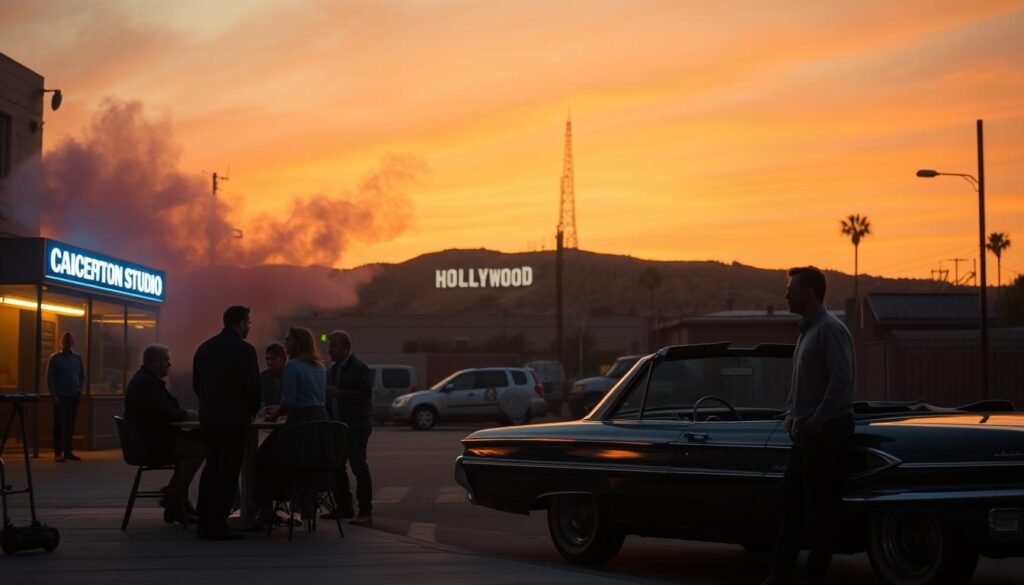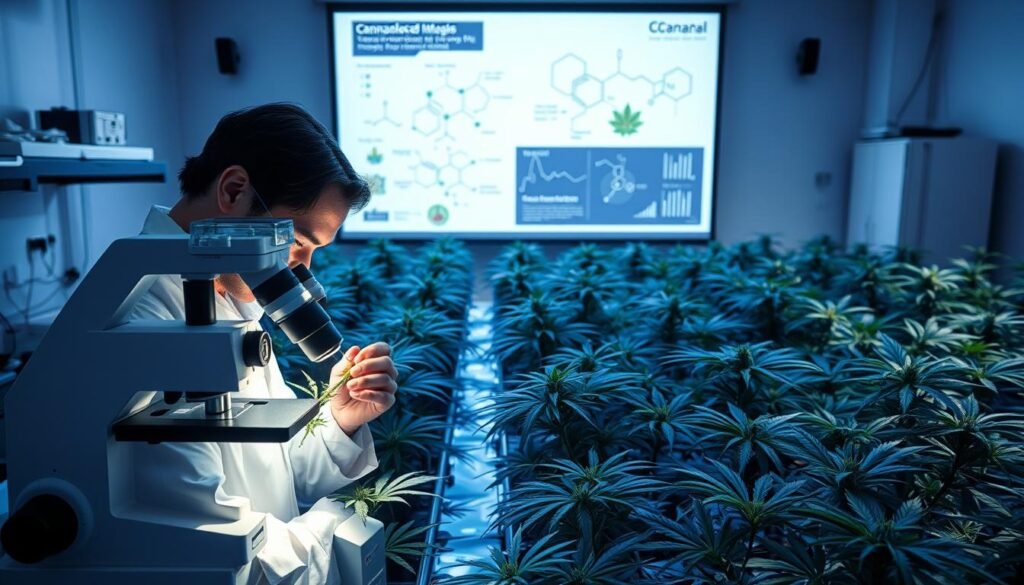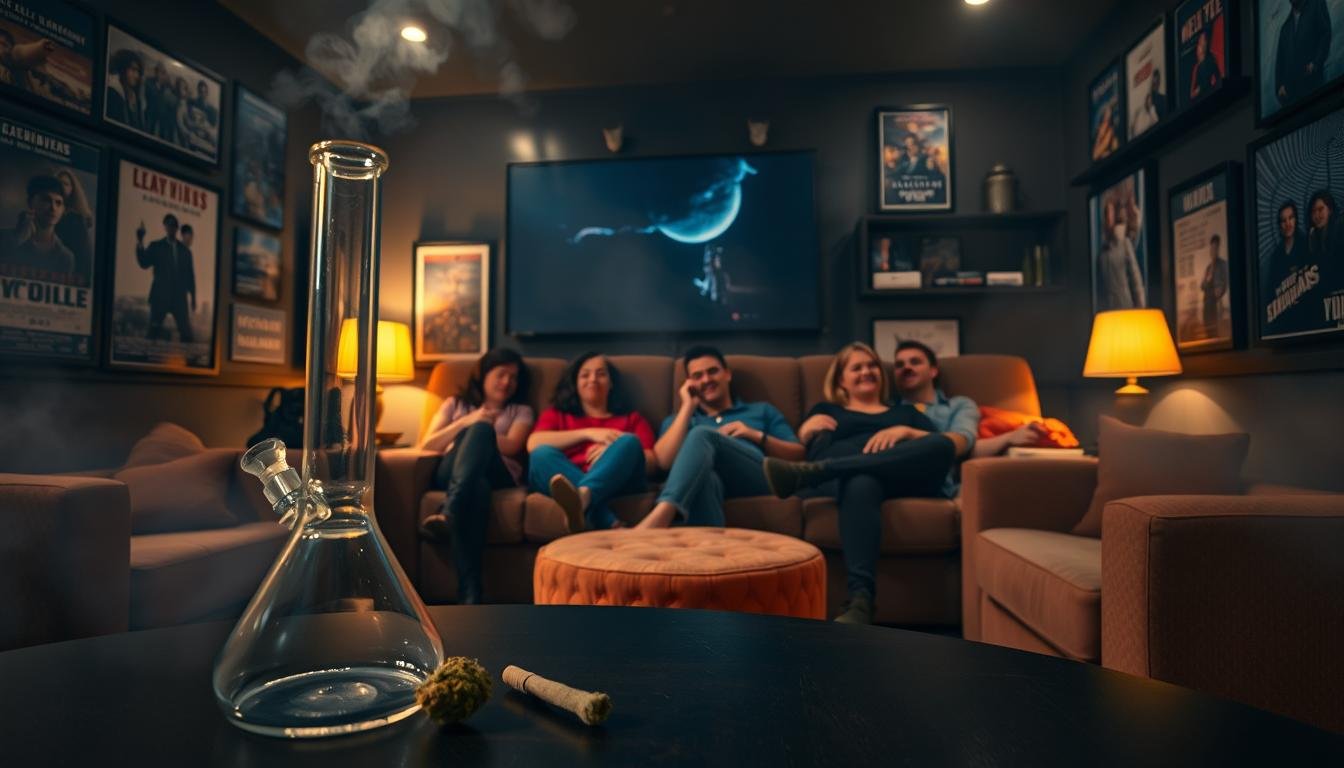Have you ever wondered how films show the effects of cannabis so well?
Movies have long shown cannabis use as a way to spark creativity and change how people see the world. Classics like “Easy Rider” and recent hits like “Pineapple Express” have made cannabis a key part of movie stories.
The science behind these scenes is as interesting as the movies themselves. It explores the mind and brain’s reactions to cannabis.
Key Takeaways
- The way movies show cannabis has changed a lot over the years.
- Cannabis in movies is often tied to creativity and feeling different.
- The science of cannabis effects is all about the mind and brain.
- Films like “Easy Rider” and “Pineapple Express” have made cannabis important in movies.
- How movies show cannabis can shape how people see it and think about it.
The Neuroscience of Cannabis and Its Cinematic Portrayal
Cinema shows how cannabis affects us, thanks to THC, CBD, and the brain’s endocannabinoid system. This field, cannabis science, is really interesting. It looks into how these substances change how we see things, feel, and think.
How THC and CBD Interact with the Brain
THC and CBD are key parts of cannabis. THC makes us feel high by binding to brain receptors. This can change how we see and feel things. CBD doesn’t make us high but can change how THC works. It’s also being studied for its health benefits.
Endocannabinoid System Basics
The endocannabinoid system is a big network in our bodies. It helps control things like mood, memory, and hunger. Knowing about this system helps us understand how cannabis affects our brains.
| Cannabinoid | Effect on the Brain |
|---|---|
| THC | Binds to cannabinoid receptors, altering perception and mood. |
| CBD | Influences THC’s effects and has potential therapeutic benefits. |
Filmmakers who get cannabis right make their stories more believable. By knowing how cannabis works, they can tell more real and interesting tales.
Evolution of Cannabis Representation in Cinema
The way cannabis is shown in movies has changed a lot. At first, films like “Reefer Madness” (1936) made it seem very bad. They helped spread negative ideas about it.
From Reefer Madness to Medical Acceptance
In the early 20th century, movies made cannabis look bad. They said it led to crime and moral problems. This was because of the propaganda of that time.
1930s-1960s: Propaganda and Fear
From the 1930s to the 1960s, films used cannabis to scare people. Movies like “Reefer Madness” and “Marihuana” (1936) showed its dangers.
But, as people’s views changed, so did movie portrayals. The 1970s and 1980s showed cannabis in a different light. It was linked to the counterculture.
Today, movies show a more balanced view of cannabis. They explore its medical uses. This change shows how society is accepting it more.
Key changes in cannabis representation include:
- Early negative portrayals giving way to more balanced views
- Increased focus on medical cannabis and its therapeutic potential
- A shift from propaganda to nuanced storytelling
The way movies show cannabis has changed a lot. It reflects how society has moved from fear to understanding.
Iconic Cannabis Films and Their Cultural Impact
Iconic cannabis films have entertained us and shaped how we see cannabis. They’ve made cannabis seem normal and cool in our culture.
Classic Stoner Comedies
Classic stoner comedies are key to cannabis culture. They bring laughter and change how we see cannabis. Movies like Up in Smoke, Friday, and Harold & Kumar are part of our shared culture.
Up in Smoke, Friday, and Harold & Kumar
Up in Smoke (1978) with Cheech and Chong was a big hit. It made cannabis funny. Friday (1995) showed cannabis in daily life. Harold & Kumar (2004) mixed humor with a cannabis quest.
These films show how society views cannabis. They make it seem okay by making it funny.
Their impact is clear. They’ve set the stage for more stoner comedies. They’re loved for their humor and cultural value.
Visual and Technical Methods for Depicting Cannabis Effects
Filmmakers use many techniques to show how cannabis affects people. They aim to make the viewer feel like they’re part of the story. It’s not just about telling a story; it’s about creating a visual and sensory experience.
Cinematography Techniques
Cinematography is key in showing the effects of cannabis. Slow motion and close-ups help highlight how characters feel when they’re under the influence.
Lens Choices and Camera Movements
The type of lens and camera movement greatly impacts how cannabis use is shown. A wide-angle lens captures the surroundings and how characters interact with them. On the other hand, a telephoto lens focuses on the character’s emotions.
Camera movements like tracking shots and handheld camera work make scenes feel more real. They make the viewer feel like they’re right there with the characters.
| Cinematography Technique | Effect on Viewer |
|---|---|
| Slow Motion | Enhances the surreal or euphoric feeling associated with cannabis use. |
| Close-ups | Highlights the character’s reactions and emotions. |
| Wide-Angle Lens | Captures the character’s interaction with their environment. |
By choosing and mixing these techniques, filmmakers can show the effects of cannabis in a way that grabs the audience’s attention. This makes the story more engaging and immersive.
Weed Science in Movies: Separating Fact from Fiction
Movies often get cannabis science wrong, focusing on fun over facts. This can make people think cannabis works differently than it really does.
Common Exaggerations and Inaccuracies
Cannabis films make THC’s effects seem way bigger for drama. They show cannabis causing wild hallucinations or odd behaviors that don’t happen in real life.
But, cannabis does change how you see things and feel. It’s not usually as extreme as movies show. Studies say these big effects are rare and often because of other things, like someone’s mental state or other drugs.
Comedies like “Pineapple Express” or “Harold & Kumar Go to White Castle” make cannabis seem more fun than it is. But, these movies can still change how people see cannabis.
It’s key to know the cannabis science to tell fact from fiction. THC affects the brain’s endocannabinoid system, changing mood, perception, and memory. Cannabis can help, but how it affects you depends on many things, like how much you use and how you take it.
Looking at fact vs. fiction in cannabis films helps us understand how movies shape our views on cannabis. This way, we can watch movies with a critical eye and look for real facts about cannabis.
Cannabis in Hollywood: Industry Perspectives and Box Office Impact
Stoner films have found a profitable spot in Hollywood. Their success has made people curious about cannabis’s role in movies. As views on cannabis change, so does its movie portrayal.
The Economics of Stoner Films
Stoner films are made with low budgets but can make a lot of money. This makes them popular in the film industry.
- Low production costs
- High box office returns
- Increased merchandising opportunities
Budget vs. Return Analysis
Looking at stoner films’ budgets and profits shows their success. Movies like Pineapple Express and The Hangover made a lot more than they cost to make.

Stoner films are not just hits with fans but also make money. With the cannabis industry growing, these films will likely stay popular in Hollywood.
Here are some key stats on stoner films’ success:
- Average production budget: $20 million
- Average worldwide gross: $100 million
- Return on investment: 500%
Actor Preparation and Performance of Stoner Effects
To really show stoner effects, actors need a deep approach to character development. They must do lots of research and prepare well to act believably.
Research Methods and Character Development
Actors use many ways to learn about cannabis use. They might consult with experts or use personal experience. This helps them show characters who use cannabis in a real way.
Consulting with Experts vs. Personal Experience
Some actors like to talk to experts to learn more about cannabis. Others use their own experiences. The choice depends on the actor’s comfort and the role’s needs.
| Research Method | Description | Benefits |
|---|---|---|
| Consulting Experts | Actors consult with cannabis experts to gain insights into its effects. | Provides accurate and detailed information, enhancing authenticity. |
| Personal Experience | Actors draw from their own experiences with cannabis. | Offers a personal and nuanced understanding, potentially leading to a more realistic performance. |
The secret to a great performance is finding the right balance between research and creativity. This way, actors can add depth and truth to their roles in movies.
The Intersection of Cannabis Science and Entertainment
Films now show cannabis in a new light, blending entertainment with education. This change shows how society views cannabis differently. It’s now seen as a valid topic for mainstream media.

Educational Value in Entertainment
Cannabis films do more than entertain. They open a door to cannabis culture and science. They show the good, bad, and everything in between about cannabis use.
When Films Teach About Cannabis
Even comedies like “Pineapple Express” and “The Hangover” touch on cannabis. Serious films and documentaries dive into its medical benefits and legal issues.
These films make cannabis relatable and less mysterious. They show how it affects people in different ways. This highlights the need for using it responsibly.
| Film Title | Educational Aspect | Cannabis Depiction |
|---|---|---|
| Pineapple Express | Cannabis culture, legal issues | Comedic, exaggerated |
| Sicko | Medical cannabis, healthcare | Serious, documentary-style |
| The Hangover | Cannabis use, consequences | Comedic, realistic effects |
Watching these films helps us understand cannabis better. As the cannabis industry grows, so does the role of educational films.
Conclusion: The Future of Cannabis Portrayal in Film
As society’s views on cannabis change, so will how it’s shown in movies. The growing acceptance of cannabis has led to more detailed and realistic movie scenes. These scenes are moving away from old stereotypes.
Cannabis in movies has changed a lot. From the over-the-top scenes in “Reefer Madness” to today’s more realistic films. The future of cannabis movies will be influenced by legal changes and public opinion.
The role of cannabis in Hollywood is becoming more important. With the cannabis industry expanding, we’ll see more varied and accurate movie scenes. This will shape the future of cannabis films.
FAQ
What is the endocannabinoid system and how does it relate to cannabis effects in films?
The endocannabinoid system is a complex network in our bodies. It helps control mood, appetite, and pain. THC and CBD, found in cannabis, interact with this system. This interaction is what films often show.
How have societal attitudes towards cannabis influenced its depiction in films?
As people’s views on cannabis have changed, so has how it’s shown in movies. From early films like Reefer Madness to today’s more realistic portrayals, movies reflect our shifting views.
What are some iconic cannabis films, and how have they contributed to the normalization of cannabis use?
Films like Pineapple Express and Dazed and Confused have become cultural icons. They’ve helped make cannabis use seem more normal and shaped our views of cannabis culture.
How do filmmakers use cinematography techniques to portray cannabis effects?
Filmmakers use various techniques, like camera movements and lighting, to show cannabis’s effects. These techniques help bring the experience to life on screen.
Are cannabis portrayals in movies scientifically accurate?
Some films aim for accuracy, but many exaggerate or get it wrong. This mix of truth and Hollywood flair is common in cannabis movie portrayals.
What is the economic impact of cannabis-themed films?
Films about cannabis, like stoner comedies, can be very profitable. They’ve brought in a lot of money at the box office, helping the cannabis industry grow.
How do actors prepare for roles involving cannabis use?
Actors research cannabis culture and its effects to get their roles right. They aim to portray stoner characters and experiences authentically.
Can cannabis-themed films educate viewers about cannabis science and culture?
Yes, these films can teach viewers about cannabis science, culture, and history. They offer a unique blend of entertainment and education.
How might changing societal attitudes and legal landscapes influence cannabis representation in cinema?
As attitudes and laws evolve, films will likely show cannabis in more complex ways. This reflects a deeper understanding of cannabis culture.

